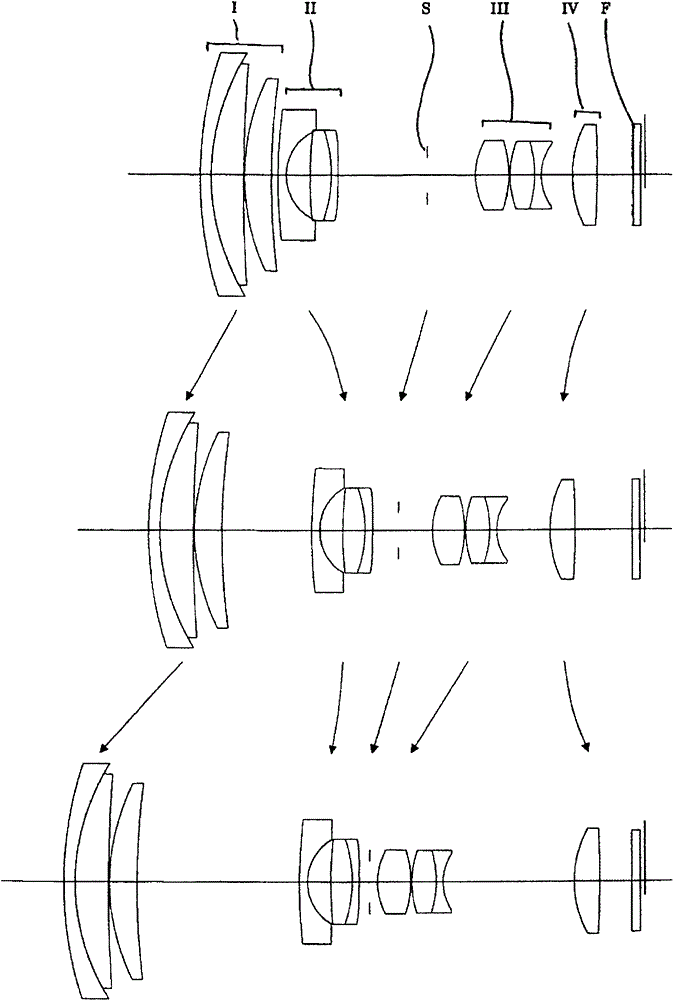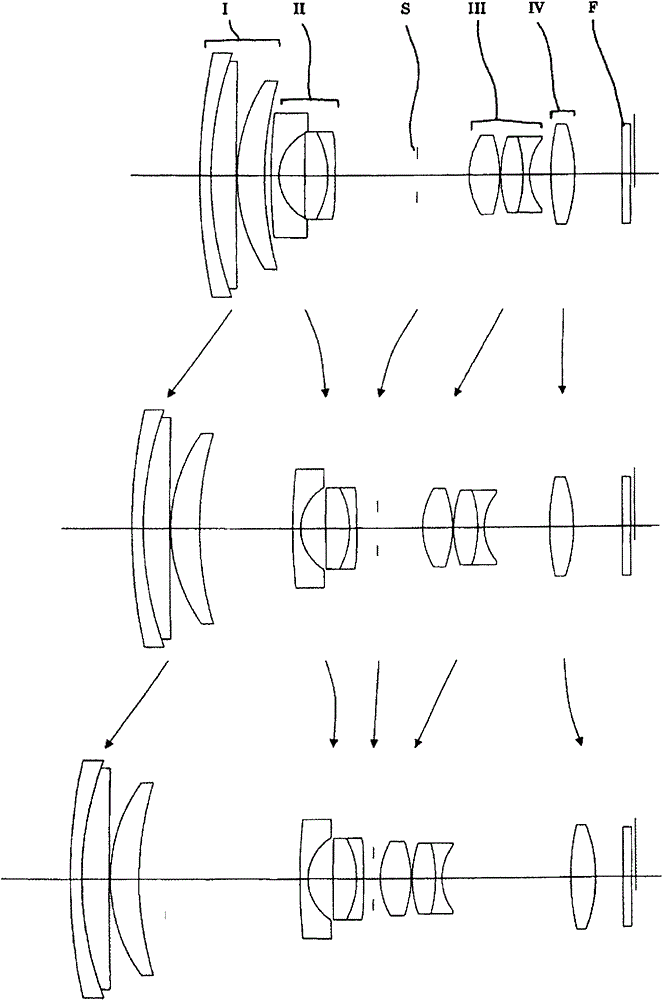Zoom lens unit, imaging device and portable information terminal device
A zoom lens and unit system technology, applied in optical elements, instruments, optics, etc., can solve the problems of shortening the collapsed state of the zoom lens unit, insufficient zoom lens unit, and overall length reduction.
- Summary
- Abstract
- Description
- Claims
- Application Information
AI Technical Summary
Problems solved by technology
Method used
Image
Examples
example 1
[0312] Table 1
[0313] f=5.07-34.50, F=3.48-5.65, ω=39.79-6.52
[0314]
[0315]
[0316] Aspheric surface (aspheric surface is the surface with an asterisk "*" in the above data. The situation is similar in the following example).
[0317] Sixth surface
[0318] K=0.0, A 4 =2.47187×10 -5 , A 6 =-2.33739×10 -6 , A 8 =1.40335×10 -7 ,
[0319] A 10 =-3.70011×10 -9 , A 12 =3.54383×10 -12 , A 14 = 6.39319×10 -13
[0320] Tenth surface
[0321] K=0.0, A 4 = -3.99709×10 -4 , A 6 = -3.19281×10 -6 , A 8 =-1.20904×10 -7 ,
[0322] A 10 =-3.19854×10 -8
[0323] Twelfth surface
[0324] K=0.0, A 4 =-8.15177×10 -4 , A 6 =1.43767×10 -5 , A 8 =-1.42505×10 -6 ,
[0325] A 10 =9.97953×10 -8
[0326] Thirteenth surface
[0327] K=0.0, A 4 =5.34757×10 -4 , A 6 =2.83041×10 -5 , A 8 =-2.34413×10 -6 ,
[0328] A 10 =1.69514×10 -7
[0329] Seventeenth surface
[0330] K=0.0, A 4 = -1.04517×10 -4 , A 6 =7.81280×10 -6 , A 8 = -2.51666×10 -7 ,
[0331] A 10 =4.09360×10 -9
[0332] Table 2
[0333] variable
[0334]
Short...
example 2
[0345] table 3
[0346] f=5.07-34.53, F=3.45-5.61, ω=39.75-6.55
[0347]
[0348]
[0349] Aspheric surface
[0350] Sixth surface
[0351] K=0.0, A 4 = 4.38118×10 -5 , A 6 =-3.28212×10 -6 , A 8 =1.67801×10 -7 ,
[0352] A 10 = -4.32537×10 -9 , A 12 =-1.26659×10 -11 , A 14 =1.27763×10 -12
[0353] Tenth surface
[0354] K=0.0, A 4 =-4.80018×10 -4 , A 6 = -4.53081×10 -6 , A 8 = -2.73503×10 -7 ,
[0355] A 10 = -5.07166×10 -8
[0356] Twelfth surface
[0357] K=0.0, A 4 =-8.76064×10 -4 , A 6 =1.71719×10 -5 , A 8 =-1.39333×10 -6 ,
[0358] A 10 =9.31505×10 -8
[0359] Thirteenth surface
[0360] K=0.0, A 4 =5.89357×10 -4 , A 6 =3.03606×10 -5 , A 8 =-2.25267×10 -6 ,
[0361] A 10 =1.54591×10 -7
[0362] Seventeenth surface
[0363] K=0.0, A 4 =-5.88625×10 -5 , A 6 =1.08911×10 -5 , A 8 = -4.32420×10 -7 ,
[0364] A 10 =7.34514×10 -9
[0365] Table 4
[0366] variable
[0367]
Short focal end
Intermediate focal length
Telephoto end
f=5.075
f=13.180
f=34.531
A
0.600
8.169
14.520
B
...
example 3
[0378] table 5
[0379] f=5.07-34.45, F=3.44-5.57, ω=39.77-6.81
[0380]
[0381] Aspheric surface
[0382] Fourth surface
[0383] K=0.0, A 4 = -2.61959×10 -6 , A 6 = -4.61000×10 -8 , A 8 =4.12097×10 -10 ,
[0384] A 10 = -2.83406×10 -12
[0385] Sixth surface
[0386] K=0.0, A 4 =4.69989×10 -5 , A 6 = -6.00298×10 -6 , A 8 =2.85972×10 -7 ,
[0387] A 10 = -4.67475×10 -9 , A 12 =-8.20307×10 -11 , A 14 =2.46554×10 -12
[0388] Tenth surface
[0389] K=0.0, A 4 = -5.17867×10 -4 , A 6 = -9.91338×10 -6 , A 8 = -2.02961×10 -7 ,
[0390] A 10 = -5.38642×10 -8
[0391] Twelfth surface
[0392] K=0.0, A 4 = -7.45563×10 -4 , A 6 =1.45957×10 -5 , A 8 = -1.41743×10 -6 ,
[0393] A 10 =1.11141×10 -7
[0394] Thirteenth surface
[0395] K=0.0, A 4 =7.01916×10 -4 , A 6 =2.59719×10 -5 , A 8 =-2.44987×10 -6 ,
[0396] A 10 =1.76570×10 -7
[0397] Seventeenth surface
[0398] K=0.0, A 4 =-2.49031×10 -5 , A 6 = 6.74925×10 -6 , A 8 =-2.86346×10 -7 , A 10 =4.04476×10 -9
[0399] Table 6
[0400] variable
[0401]
Short...
PUM
 Login to View More
Login to View More Abstract
Description
Claims
Application Information
 Login to View More
Login to View More - R&D
- Intellectual Property
- Life Sciences
- Materials
- Tech Scout
- Unparalleled Data Quality
- Higher Quality Content
- 60% Fewer Hallucinations
Browse by: Latest US Patents, China's latest patents, Technical Efficacy Thesaurus, Application Domain, Technology Topic, Popular Technical Reports.
© 2025 PatSnap. All rights reserved.Legal|Privacy policy|Modern Slavery Act Transparency Statement|Sitemap|About US| Contact US: help@patsnap.com



